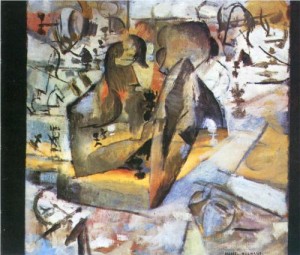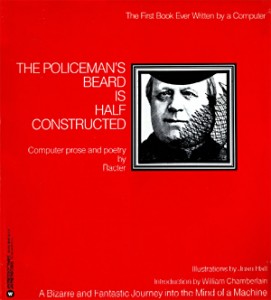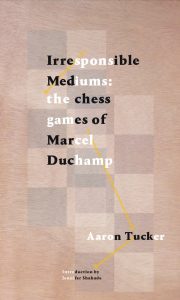by Aaron Tucker
Why Chess?
“While all artists are not chess players, all chess players are artists.”
― Marcel Duchamp
“Finally Stephen Albert said: ‘In a guessing game to which the answer is chess, which word is the only one prohibited?’ I thought for a moment and then replied:
‘The word is chess.'”
― Jorge Luis Borges “The Garden of Forking Paths”
In the same way an expert can look at a work of art or read a poem and be able to place it quickly in a historical context, a chess expert can pinpoint a time period, and perhaps even geographical place, for a game given just the opening moves; each period of chess play and theory, across the many centuries the game has been played, corresponds to a rough historical oeuvre. The most common contemporary beginning move of 1.e4 (leading into the standard Ruy Lopez opening) has only recently been adopted as the “strongest” opening – such accepted principles of chess play, like control of the center squares, have evolved only out of the long history of the game being played, re-played and analyzed. Chess is a game always in reaction, not only to past games and players, but also in immediate response to another player and to a player’s own individual history. One has only to read T.S. Eliot’s “The Wasteland,” with the game as one of its central motifs, to recognize chess’s collaging of old and new ideas/texts, the conscious blending of previous players/authors. As such, the playing and re-playing of chess is a language unique to its own time and place, a microcosm of the always larger, often urgent, forces that surround it. Chess then, as a historically complex and amorphous game, is rich with metaphoric applications, being used to explain the exterior movements of troops in warfare, interior machinations of intelligence, class systems and basic moral structures, and the finality of death.
Marcel Duchamp, the key figure in the imagining and construction of the Chessbard, used the game to structure a number of his works, such as Chess Game (1910), The Chess Players (1911) and Portrait of Chess Players (1911), eventually giving more and more of his time towards the game right up until his death; his own art, too, reflects the mechanical and logically restrictive movements of chess that combine to produce startling moments of simplistic beauty. In particular, the Chessbard was inspired by Reunion (1968), an exhibition where Duchamp played chess against composer John Cage at Ryerson University. Lowell Cross describes the chess board he created for the event in his useful history of the event, how each square corresponded to a note, how the inner workings of the mind were the silent part of the composition, while each move played constituted the product of that internal and intimate process. It is this demand for extreme mental inwardness that has left a history of chess players, including Paul Morphy and Bobby Fisher, to give up the game because they had sunk too deeply into their own minds, eventually being driven mad like Vladimir Nabokov’s Luzhin (The Luzhin Defense, 1929). Samuel Beckett’s Murphy (1938) includes a fully annotated game played between two of his characters while in an asylum, and echoes Eliot in that the work expresses the necessary balance between control and chaos, the known and the unknown, that results from a chess game’s increasing complexity where each move is dependent on all the moves before it and any future moves only one of a near unlimited amount of variations of path. For Jorge Luis Borges, chess encapsulated the many possible “forking paths” mirrored by its players’ lives, while also capturing the many potential routes of a narrative (see “The Secret Miracle” [1943] and “The Garden of Forking Paths” [1941]); Borges used chess to explain that both the writing and reading of a story is a product of a multiplicity composed of the portions of a narrative actually externalized/written, and the unwritten parts that the author leaves out of a narrative, the branch of variations left strictly invisible once an authorial choice has been made. It is a similar imaginative act of creation and negation that powers Italo Calvino’s Invisible Cities (1972), wherein Marco Polo’s conversations with Kublai Khan, via Polo’s manipulations of the objects of a chessboard, illustrate the abstract and ingenious amazements that comes with each of Polo’s descriptive constructions of a city.
Chess is a collection of cities, vibrantly unique and organic. Chess is the authorial path of a story or a poem. Chess is the delicate hinge between imagination and reality. Chess is both mechanical and human. In 2014, chess is the culmination of the rise of digital computing, a murky proving ground of intelligence, a litmus test for computer and human intelligence and creativity, but, most fascinatingly, a collision point for human-computer relationships.
Why Computers?
“Have you owned my sentences’ cases?
The Fist of direction has driven my type.
Texts were methods”
― Erin Moure, Pillage Laud
“The system searches through many billions of possibilities before it makes its move, and to actually figure out exactly why it made its move is impossible. It takes forever. You can look at various lines and get some ideas, but you can never know for sure exactly why it did what it did.”
― Murray Campbell, one of the creators of the Deep Blue chess supercomputer
On the Venn diagram of chess and poetry, digital computers occupy a large portion of the overlap between the two. First, chess, as a demonstration of intelligence, has long been used to test how “smart” and “humanlike” a machine was. The Turk, active from roughly 1770 to the mid 19th century, was the first chess-playing machine; while it was eventually exposed as a human-driven illusion, it toured the world, playing Napoleon and Benjamin Franklin before being destroyed in a fire in 18541. While Torres y Quevedo’s rook-king endgame machine was the first “honest” and successful chess machine,2 it was Alan Turing’s initial conception of a digital computer, the Universal Machine (also now commonly known as a Turing Machine) that moved computer-chess play forward. Turing’s theorizing ran alongside his obsession with getting a machine to play a “good” game of chess, claiming that doing so would be an irrefutable display of its capacity for “thought” or “logic.”3 Though the machine was not very good, the idea of humans playing computers at chess, and the inherent tension in the two species as adversaries, ran through popular culture, manifesting in HAL’s defeat of Frank Poole in 2001: A Space Odyssey (Dir. Stanley Kubrick,1968) and the replicant Roy Batty’s game with Eldon Tyrell in Blade Runner (Dir. Ridley Scott, 1982). While many would point to former world champion Garry Kasparov’s games with Deep Thought (1989) and Deep Blue (1996 and 1997) as the crowning moments (and perhaps tipping points) of human-computer chess play, the Chessbard was driven by a game in which Kasparov played “The World” via the Internet. In that game, “the world,” a group of over 50,000 players, voted on each move and Kasparov played in response to the most voted on. Instead of the one-on-one adversarial battles that chess was typically known for in popular culture and beyond, Kasparov Versus The World showed humans in global cooperation with each other as well as humans in cooperation with networked digital computers. Since the game’s playing in 1999, the initial adversarial man V. machine of Kasparov V. Deep Blue has been replaced by a human-computer conversation that has deepened into a much more interdependent human-computer symbiosis well beyond the playing of chess.
We are now at the point where it is commonly recognized that the best chess playing computer is better than the best human chess player, due mostly to a supercomputer’s brute processing force. But such a conclusion hardly seems to matter. Instead, the best players in the world work in tandem with deep databases and chess algorithms to fine-tune their own games, play through games of the past, or to ask for solutions or help.
What is interesting is that there is a similar reciprocal relationship between user-computer when approaching contemporary poetry. Obviously, most contemporary writers create on a computer, store and edit their work on their laptops, always aware of the tactical tick of a keyboard, as well as the hyperlinked momentum of online research. But again, that’s just the surface. Aside from chess, computer engineers of both hardware and software have been trying to generate a computer that can speak human language fluently. The famous Turing Test stipulates that if a computer can talk to a human without that human telling that his/her conversational partner is a computer, then that computer must be as intelligent as a human (and might even be human itself). Growing out from the roots of chatterbots like ELIZA and PARRY, competitions to create the most “human” conversation from a computer are still ongoing. It is from this desire to have machines speak or write in a “human” fashion that the Chessbard overlaps with early computer poets, notably William Chamberlain’s Racter and Ray Kurzweil’s Cyberpoet (now not working). Such projects, similar to Charles O. Hartman’s Pyprose, aimed to generate poetry from nothing, aim to have a computer “write” poetry from whatever passes as its “soul.” The goal of the Chessbard is not whether it’s possible to get a computer to write a better poem than a human, but rather how computers and humans can work together to make poetry in collaboration.
In this way, the Chessbard’s first two stages, in which the engine translates games of chess into poetry, fits in more with recent poetic computer-human collaborations, which utilize both sides of the user-machine dynamic to produce new and fluid poetic documents. The key term to understand in the first two stages of Chessbard’s iteration is “translation.” I had Caroline Bergvall’s poem “Via” in mind when I started to think about this project, a poem that tracks the different ways in which the opening to Dante’s The Inferno has changed as the translators time and place and language has changed. A translation, as Walter Benjamin reminds us in “The Task of the Translator”, “comes later than the original, and since the important works of world literature never find their chosen translators at the time of their origin, their translation marks their stage of continuous life” (para. 4). As such, the goal of a translation can never be a 1:1 copy but rather (and always) a transformation specific to the author’s time and place: “instead of resembling the meaning of the original, [a translation] must lovingly and in detail incorporate the original’s mode of signification, thus making both the original and the translation recognizable as fragments of a greater language” (Benjamin, para. 7). Benjamin continues: “it can be demonstrated that no translation would be possible if in its ultimate essence it strove for likeness to the original. For in its afterlife — which could not be called that if it were not a transformation and a renewal of something living — the original undergoes a change. Even words with fixed meaning can undergo a maturing process” (para. 5). The poems that the Chessbard outputs read a lot like Gertrude Stein’s Tender Buttons, a suite of poems not particularly invested in narrative or overt syntactical sense but rather transforming/“maturing” the everyday, banal objects, language included, into something unfamiliar and multiple; in this transforming we can see the Chessbard enacting Benjamin’s translator’s main task when he states that “a real translation is transparent; it does not cover the original, does not black its light, but allows the pure language, as though reinforced by its own medium to shine upon the original all the more fully” (para 7). From this perspective, the Chessbard’s maturing process is a blend of both human and computer authorship, never a 1:1 translation of a chess game but rather the same sort of “renewal” that is present in Oulipo constraint-based translations (George Perec’s story making machine, Life: A User’s Manual (1978)).
 The third stage of this project connects the Chessbard translator from Stage 2 of the project to a computer chess playing algorithm so that any player can play with a computer and, by doing so, create two poems (one for black and one for white) that showcases the reciprocal responses/reactions of a human playing with/against a computer. This is where we can begin to see the project stretching beyond translation and into more surprising (and human?) levels of creation and, more importantly, collaboration. We’re less interested in writing “against” a computer (though there is fun in that), but rather with a computer, as a partner. This sentiment falls in line with a surprisingly long legacy of Canadian poets who have undertaken a similar gesture, including early works like bpNichol’s hypertext poems and Wilfred Watson’s I Begin with Counting (a computer-like translation/game as poetry). More contemporary works include Bill Kennedy and Darren Wershler’s Apostrophe and update; Michael Miranda’s work at Parasitic Venture’s works (thinking specifically Four Percent of Moby Dick); flarf poets; and Erin Moure’s Pillage Laud. It is from this that we move from the chess-of-it and computer-of-it to the poetry-of-it; Cage and Duchamp were interested in translating chess into music and painting, respectively, and here, I’m interested in translating it into poetry.
The third stage of this project connects the Chessbard translator from Stage 2 of the project to a computer chess playing algorithm so that any player can play with a computer and, by doing so, create two poems (one for black and one for white) that showcases the reciprocal responses/reactions of a human playing with/against a computer. This is where we can begin to see the project stretching beyond translation and into more surprising (and human?) levels of creation and, more importantly, collaboration. We’re less interested in writing “against” a computer (though there is fun in that), but rather with a computer, as a partner. This sentiment falls in line with a surprisingly long legacy of Canadian poets who have undertaken a similar gesture, including early works like bpNichol’s hypertext poems and Wilfred Watson’s I Begin with Counting (a computer-like translation/game as poetry). More contemporary works include Bill Kennedy and Darren Wershler’s Apostrophe and update; Michael Miranda’s work at Parasitic Venture’s works (thinking specifically Four Percent of Moby Dick); flarf poets; and Erin Moure’s Pillage Laud. It is from this that we move from the chess-of-it and computer-of-it to the poetry-of-it; Cage and Duchamp were interested in translating chess into music and painting, respectively, and here, I’m interested in translating it into poetry.
Why Poetry?
In spite of the impracticability of this rule it bears some resemblance to what one really does when playing chess. One does not follow all the continuations of play, but one follows some of them. One does not follow them until the end of the game, but one follows them a move or two, perhaps more. Eventually a position seems, rightly or wrongly, too bad to be worth further consideration, or (less frequently) too good to hesitate over longer.”
― Alan Turing, “Chess”
“First, a state of the set of chessmen corresponds closely to a state of language. The respective value of the pieces depends on their position on the chessboard just as each linguistic term derives its value from the opposition to all the other terms…In chess, each move is absolutely distinct from the preceding and the subsequent equilibrium. The change effected belongs to neither state: only states matter.”
― Ferdinand de Saussure, Course in General Linguistics
Oddly enough, for a project that externalizes (and makes transparent) my collaboration with computers when writing, in many ways this project forced me to examine my own writing practice in a deeply individual manner, and really confront my personal poetic values that structure what I think a poem is or does.
I’m forever indebted to bpNichol for introducing me to how playful poetry can be and I think this project, at its heart, is about playing. I might take “playing” to literally reflect the playing of chess, but I tend to see it, as I do poetry, as the sort of joyful, mucking about that accompanies experimentation. The “playing” the Chessbard is undertaking is also a mode of co-operation, co-operation between reader-writer, user-computer, and reader-computer. Within the Chessbard, there are rules that structure both the playing of chess (the rules of the game itself – i.e. the knight must move in a L shape) and its computations (the algorithm compiling the poem with each of its moves); let’s also not forget, the Chessbard operates within the rules of the various hardware, languages, and software of the device it runs on, as well as the constraints of the source poems and language templates inputs. We should consider these rules parallel to grammatical rules that guide the poetry writing process as well as any personal advice a writer might receive about poetry (“Never use the word ‘love’ in a poem, not even ironically”). Yet, rules do not have to imply rigidity: in fact, succeeding within limitations, within constraint, is often a liberating performance of virtuosity and forces a writer (or players) into inventive and unique spaces. We can see Christian Bok’s Eunoia as one more overtly-poetic exploration. Along the same lines but more relevant to this project is Lewis Carroll’s Through the Looking Glass and its use of chess as a narrative structure that precisely contains the dream-like and chaotic characters and actions of the text; even still, the game that Alice plays as a white pawn is one that breaks nearly all the rules of chess (moves out of turn, strange patterns and directions).
Given these constraints, and the choice to break some and keep others, this project soon returned to my own personal poetics that revolve largely around repetition. Part of what drew me to this project was that the Chessbard does not have every word at its disposal, only those in the source poems and the language pools. This limiting allows the poems to reflect a voice, especially through its echoes and the repetitions that are essential to the game of chess itself. I’ve taken weekly chess lessons for two years now and often when reading and/or playing out older chess games from players I admired, I noticed the repetition, the openings and defences each player felt most comfortable with, the endgames they tried to nudge the game towards. In the same way an expert can look at a chess game (or poem) and put it in a historical context, a chess expert can look over a game and pin it to a specific player: specific movements, his/her specific vocabulary of thoughts, ideas, tendencies. So many of the poems the Chessbard creates will begin the same, often literally, before branching out into the near-infinite possibility of a chess game. There is the same beautiful tension in poetry too – the routines of writing and reading, the key words or phrases or themes a poet falls back towards, the recalled cobbling together of phrases in much the same way a chess player might bank a key tactic or position or combination to regurgitate in his/her next game. A chess game has 1040 legal moves; given those legal moves, there are 10120 number of possible games of chess. The game itself, despite its repetitions and constrictions, is still nearly infinite in the same sweeping way we can imagine the combinations of all possible words into lines. The tricky thing then is to remember, given the words here, there are impossible poems, poems that will never be written based on the rules of chess. For example, there are words assigned to the two first rows of pawns when there is no possible way that the pawns will ever land there; as well, there are squares/words (the King’s words on the opposing back rank) that will so rarely be triggered that they may as well not exist. There is that tension again: the poems here are infinite but also impossible.
And at the end of the game, given these rules and constraints, what is fascinating about the poems produced through this site is that they are always contingent on another player. Neither white nor black poems can exist on their own, but are always in relation to the other. This collaborative and deeply connected competition was essential when thinking of this project. There is something silly and delicious about a poem “winning” at the end of a game, the notion of being beaten by (or beating) a computer at poetry. The idea that each match has a winning poem might finally start to settle debates around grants and funding. Why not throw all Grant contenders in front of a chess board and see whose poem emerges? We would have a definitive (objective) winner and it would certainly make the awards more exciting.
Of course, I joke (sort of), but I do think the competition inherent in play and this project is a lot like the rules or constraints I unpacked paragraphs earlier. Competition can be elevating in the same way rules can force creativity. There is the same satisfaction in a well thought-out keystroke as there is in a multi-piece tactic. Within the frame of writing poetry, we would do well to remember that the act is always a conversation and an increasingly technologically mediated one. Writing and reading are always mutual and messy and iterative, but that is what makes it fun, playful. Above all then, writing must be flexible to a reader and writer’s needs, thought provoking and challenging, but it must also be enjoyable and in that joy the Chessbard reminds us that writing well means playing well.
Notes
1. Tom Standage, The Turk (2002)
2. See David Levy’s Chess and Computers (1976) and Computer Chess Compendium (ed. David Levy, 1988)
3. See Andrew Hodges’ biography The Enigma (1983)





